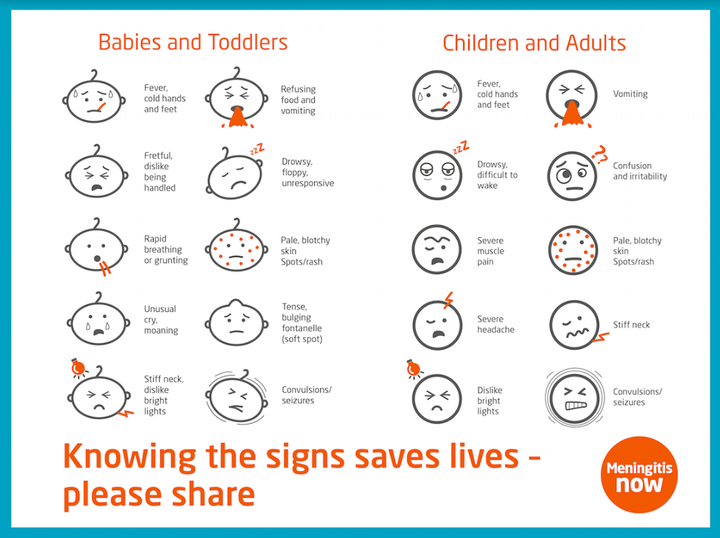The lives of babies and children could be saved if parents were given consistent, explicit advice about recognising meningitis and sepsis from health professionals, a charity has said.
The Meningitis Research Foundation said most children with meningitis or sepsis display only non-specific symptoms in the first four to six hours of illness, but can die within 24 hours.
It said almost a third (30%) of young babies with bacterial meningitis receive inappropriate early treatment which delays parents seeking further help. And around half (49%) of children who have meningococcal infection – the most common cause of bacterial meningitis – are sent home after their first visit to a GP and not admitted to hospital.
“There’s a real risk that doctors can easily miss meningitis and sepsis in the early stages,” said chief executive Vinny Smith. “Offering patients or parents of children safety netting information could be life-saving if a child with a serious illness is sent home. Parents often have a gut instinct and know when their child is seriously ill. When a child is ill and getting rapidly worse, parents should not be afraid to seek urgent medical help – even if they’ve already been seen by a doctor that same day.”

The charity’s latest report includes a summary of personal accounts of more than 100 parents whose children had meningitis but were sent home after their first visit to a health professional.
National clinical guidelines recommend that doctors listen to parents’ concerns because they know their child best, and recommend that “safety netting” information is given to parents or carers of sick children with suspected infection before they are sent home.
The charity said this should include information about meningitis and sepsis and telling parents to return for medical help if they feel their child’s symptoms do not improve or are getting worse, but in reality this information is not always given.
Mother-of-two Kirstie Walkden, from Manchester, said her nine-month-old daughter Amy became critically ill with pneumococcal meningitis in August last year – although it was not diagnosed straightaway. “Amy had seemed a bit out of sorts for a day or two,” she said. “I took her to A&E on the Sunday when her symptoms escalated; temperature, vomiting, mottled skin, fast breathing, lethargic. However, we were sent home with antibiotics for a suspected ear infection. I was surprised but felt reassured. Back at home her temperature continued to soar and by the Tuesday she was no longer eating or drinking and I couldn’t get any normal response from her.”
Kirstie said her instincts were screaming this was serious so she made the decision to take her back to hospital. “This time the hospital were amazing and within an hour they were treating her for suspected meningitis and sepsis,” she said. “The diagnosis was later confirmed as pneumococcal meningitis. We were living a nightmare and pleading for her to keep on fighting, and on day 18 she was finally well enough to come home. Only time will tell what long-term impact the disease has had on her, but so far she has exceeded all expectations.”
The charity said there are an estimated 2,500 cases of bacterial meningitis and meningococcal disease in the UK each year. It is recommending a national audit of existing meningitis guidelines to ensure that safety netting information is being provided, along with future monitoring by the Care Quality Commission to ensure safety netting advice is delivered to parents.
What are the most common symptoms in babies and children?
The NHS states the most common symptom of meningitis is the rash that looks like small, red pinpricks at first. It then spreads over the body quickly and turns into red or purple blotches.
Early symptoms in babies and children also include fever, headache, vomiting, muscle pain and fever with cold hands and feet, according to Meningitis Now. “As babies and toddlers can’t tell you how they feel, it can be easy to miss vital signs and symptoms of meningitis,” Sarah McMullen, head of knowledge at the National Childbirth Trust (NCT) warned.
“In addition to physical symptoms, parents should look for behavioural signs that include a dislike to being handled or bright lights, being drowsy or unresponsive, unusual crying or moaning, and rapid breathing. Obviously the rash is a symptom of meningitis, but this doesn’t appear in all cases. And parents should not wait until the rash appears if they are concerned about their child’s health.”
Susette Worgan-Brown, from MeningitisNow told HuffPost UK: “Meningitis and septicaemia often happen together. “Be aware of all the signs and symptoms. Symptoms can appear in any order, some may not appear at all.”
See below for Meningitis Now’s handy infographic on spotting symptoms.

How reliable is the glass test for meningitis?
The NHS states if you press the side of a clear glass firmly against your child’s skin and the rash doesn’t fade, it’s a sign of blood poisoning caused by meningitis.
“The glass test is one way to determine if a rash is non-blanching (does not fade under pressure),” said Worgan-Brown. “A sign of septicaemia is a non-blanching rash. A fever with a rash that does not fade using this test is a medical emergency. Get medical help immediately.”
What should parents do if they suspect their child has meningitis?
Worgan-Brown said if parents suspect their child has meningitis they should get medical help “immediately”. “They can contact their GP or in an emergency, dial 999 or go their nearest A&E department,” she said.
“When calling for help parents should describe the symptoms and say they think it could be meningitis or septicaemia. Early diagnosis can be difficult. If they have had medical advice, but are still concerned they should seek medical help again.”
McMullen agreed, adding: “When seeking medical assistance, it is important to alert your healthcare provider of the signs and symptoms you have seen and say that you think it could be meningitis.”
Because meningitis can be difficult to spot in the early stages, Meningitis Research Foundation has created a new information hub to help parents spot symptoms and take action when their child is unwell: www.meningitis.org/trustyourinstincts.
For more information:
To find out symptoms and treatment in babies and children, visit NHS Choices.
You can also call Meningitis Now’s helpline on 0808 80 10 388.